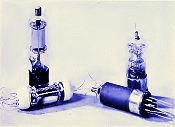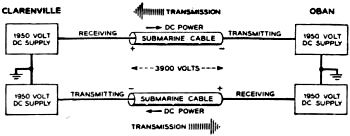20-Year Tubes for Transatlantic Cable
|
|
6p12 and 175hq vacuum tube amplifiers for the Nova Scotia-Scotland undersea cable. Who knew that the British General Post Office was once in the vacuum tube development business? This 1957 article about the world's first transatlantic telephone line (TAT-1) mentions that the amplifier and frequency equalizer repeater circuits and components for the Newfoundland and Nova Scotia section of line was their responsibility. Bell Telephone Lab handled the deep-sea portion of the system that ran between Newfoundland and Scotland. Everything was designed to have at least a 20-year service-free lifespan. TAT-1 was inaugurated September 25, 1956, and was decommissioned in 1978 without any technical failures (although a trawler did snag the cable once, causing a brief outage), thus achieving its designed longevity goal. An interesting solution was implemented to provide the high voltage requirements of the equipment while avoiding excessive dielectric thicknesses. Check this out: I found the original Bell Systems Technical Journal (January 1957) entitled "Electron Tubes for the Transatlantic Cable System." 20-Year Tubes for Transatlantic Cable Must operate reliably and unattended on ocean floor. Final designs and early models (rear) of the 175HQ (left) used in the long Newfoundland-Scotland section and the 6P12 used in the Nova Scotia-Newfoundland section. Block diagram showing voltage requirements for the Clarenville, Newfoundland and the Oban, Scotland terminals of new transatlantic telephone cable. The new transatlantic telephone cable system depends on the use of hundreds of specially designed very long life vacuum tubes housed in built-in repeaters in the cables lying on the ocean bottom. Repeaters are installed at intervals of about 40 miles in each of the pair of 2000-nautical-mile-long deep-sea cables between Newfoundland and Scotland. Each of the 102 repeaters is a 3-tube circuit used to overcome the attenuation of the cable and to equalize its nonlinear frequency response. Two main types of tubes are in operation. One, the 6P12, was developed by the British Post Office for use in the shallow-water portion of the system between Newfoundland and Nova Scotia. The other, the 175HQ, was developed at Bell Telephone Laboratories, for use in the deep-sea portion of the system between Newfoundland and Scotland. The deep-sea tube was designed to function at the lowest practical operating cathode temperature. The plate and screen voltages were reduced to the lowest values consistent with good circuit performance. In addition, electrode spacings were made large. The heaters of the tubes, requiring 225 ma. d.c., are connected in series while the plate and screen voltages for anyone repeater are obtained from the voltage drop (about 55 volts) across the heaters in that particular repeater. Hence, the power supply problem is one of feeding a steady current of 225 ma. into the cable. The tube heaters for each cable require roughly 2800 volts, and the drop in the cable itself brings the needed voltage to 3900 volts d.c. To minimize dielectric stresses, a double-ended series-aiding power feed is used as shown below. Tubes essentially like those used have been on life test for about 17 years with no failure and there is reasonable probability that these tubes will operate without failure for at least 20 years.
Posted April 22, 2024 |

